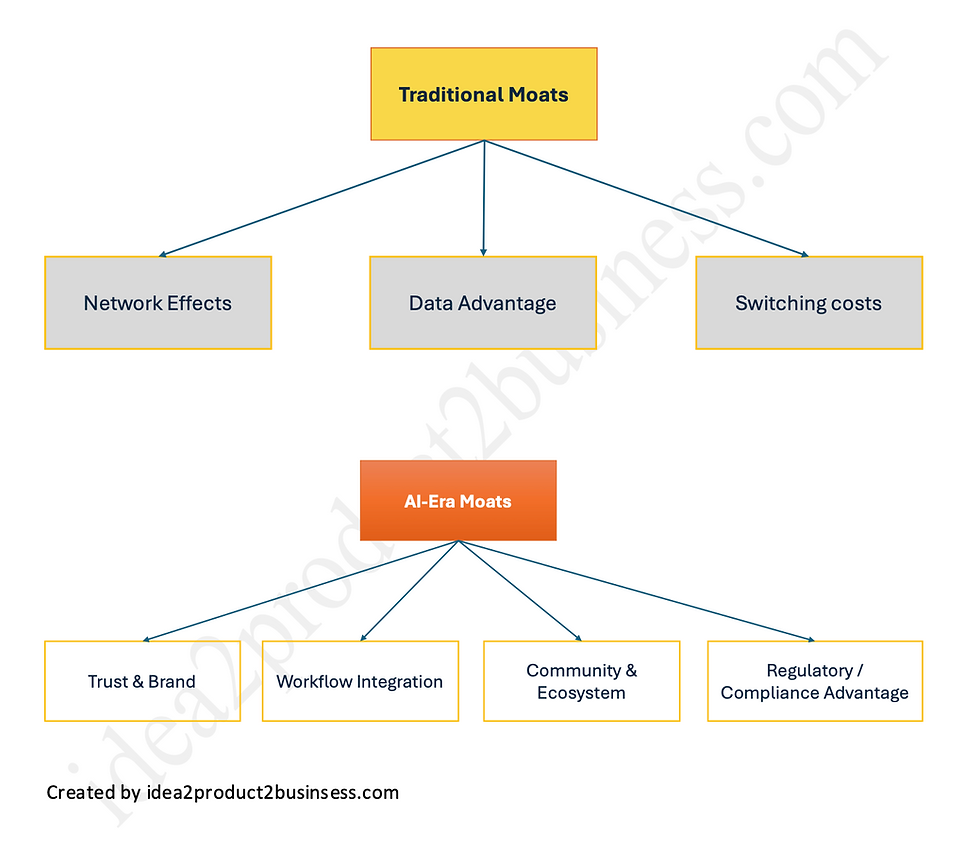Blog 102: Moats in the age of AI - can PMs still build defensible products?
- Idea2Product2Business Team

- Sep 22
- 3 min read
Updated: Oct 7
In product management circles, ‘moat’ used to mean you had something no competitor could easily copy: a secret algorithm, a massive user base, or data advantage.
Fast forward to 2025, and suddenly every competitor has access to the same AI models. The ‘secret sauce’ feels less secret when your rival can just fine-tune GPT-5 or spin up an LLaMA variant.
As product managers we need to question ourselves. If AI makes everything easier to copy, what still counts as a moat?
Why Traditional Moats Are Melting
The old playbook for defensibility looked like this:
Network effects: More users = more value.
Data advantage: Proprietary data → better models.
Switching costs: Make it painful to leave.
To learn more about traditional moats refer to our blog 62.
But AI is melting some of these down:
Network effects? Tools like ChatGPT plugins let users jump between ecosystems seamlessly.
Data advantage? Public datasets and fine-tuning frameworks have commoditised many niches.
Switching costs? AI agents can migrate data and workflows faster than ever.
In 2025, PMs are rethinking moats (in the age of AI) from first principles.

Case Study 1: Duolingo vs. the AI Copycats
Duolingo integrated AI into the learning experience early, offering personalised tutoring powered by GPT-4 (source: Duolingo Blog).
Within months, dozens of AI-first learning apps popped up — all with similar ‘personalised AI tutor’ claims.
So why is Duolingo still winning?
Brand trust: Parents trust Duolingo more than an unknown AI app.
Distribution moat: Already on millions of phones.
UX polish: AI wasn’t bolted on; it was woven into the existing gamified experience.
👉 Lesson: In an AI world, execution quality + trust can matter more than access to the tech itself.
Case Study 2: Adobe vs. AI Image Generators
When MidJourney, Stable Diffusion, and DALL-E went viral, many thought Adobe was doomed.
Instead, Adobe leaned into its moat: deep integration in workflows. In 2023, it launched Firefly, built directly into Photoshop and Illustrator (source: Adobe News).
Why it worked:
Creators didn’t have to leave their existing tools.
AI outputs were wrapped in Adobe’s licensing, addressing copyright concerns.
Adobe bundled AI with Creative Cloud subscriptions — sticky revenue stream intact.
👉 Lesson: Workflow integration + compliance = moat stronger than raw AI capability.
The Cautionary Pitfall: Shiny but Shallow
The danger in 2025 is ‘AI theatre’ — adding a chatbot, calling it innovation, and assuming that’s defensibility.
History is repeating itself: just like every company added ‘.com’ in 1999 or ‘blockchain’ in 2017, ‘AI-powered’ is today’s glitter.
👉 But glitter ≠ gold. Unless the AI is tied to deep customer value + defensible positioning, it’s a feature, not a moat.
Playbook for PMs: Building Moats in the age of AI
Here’s how PMs can rethink defensibility in 2025:
1. Double down on trust: Transparent AI policies, clear privacy handling, brand reliability.
2. Own the workflow, not the feature: Be the platform where work happens, not just where AI outputs appear.
3. Build communities, not just products: Figma thrives not only on features but a passionate design community.
4. Leverage compliance as a moat: If regulators approve your AI handling, that’s a barrier rivals can’t easily cross.
5. Design AI as invisible infrastructure: Users shouldn’t think ‘this is AI’ — they should think ‘this is magical.’
(Playbook for PMs - Building Moats in the age of AI)
To conclude, AI is commoditising technology faster than ever. The moat of the future isn’t the model you plug in, but the trust, distribution, and community you build around it.
We feel that PMs who win in 2025 won’t be shouting ‘AI-first’ — they’ll be quietly shipping products where AI is so well integrated that users forget it’s even there.
Because in the age of AI, the strongest moat is still the oldest one: deep, irreplaceable user love.
Jump to blog 100 to refer to the overall product management mind map.
I wish you the best for your journey. 😊


